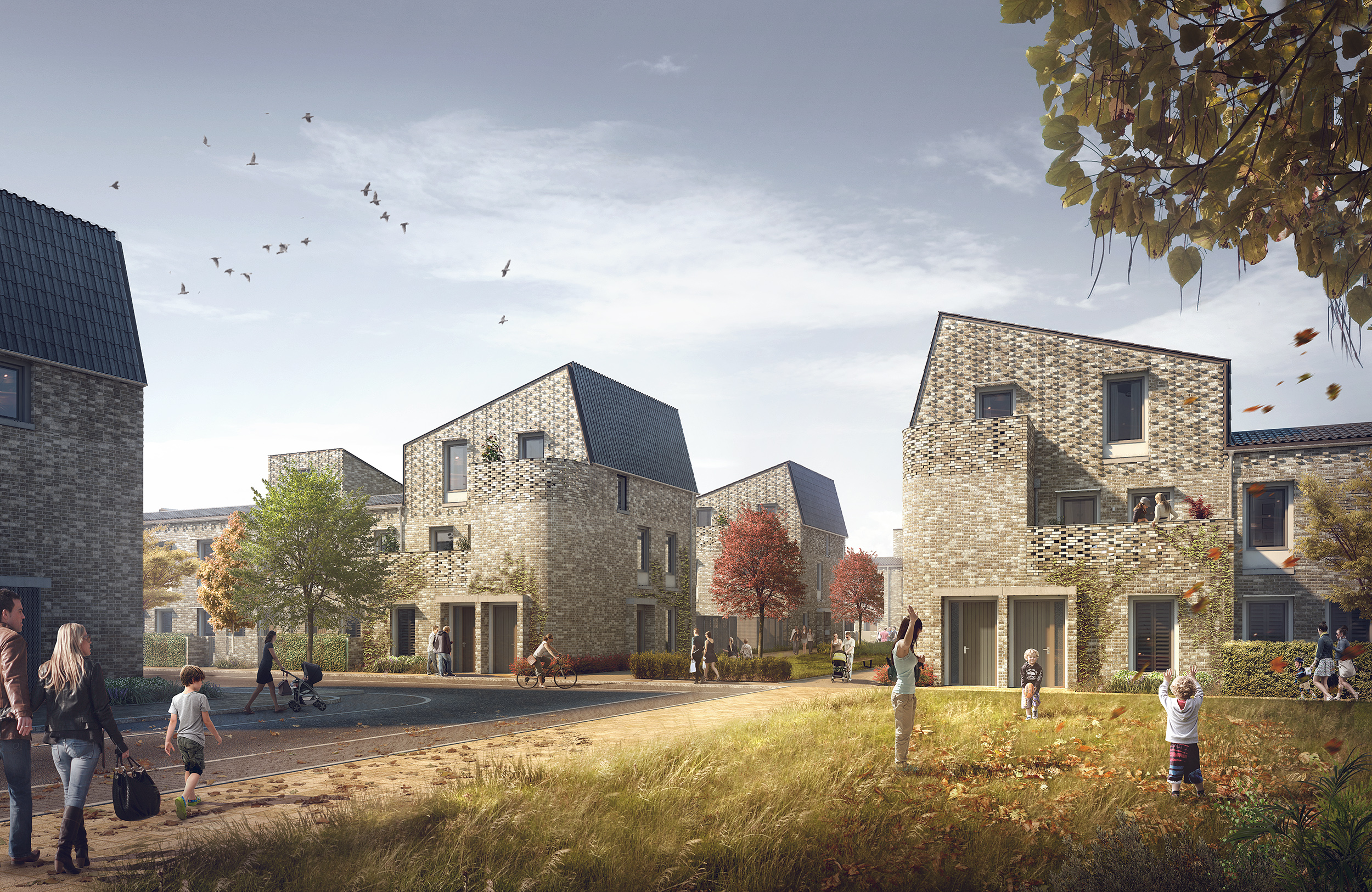When completed later this year, the new terraces of flats and houses at Goldsmith Street, Norwich will be the UK’s largest Passivhaus development. If that wasn’t ambitious enough, it is also commissioned by Norwich Council as a 100% social housing scheme. A JCT Standard Building Contract provided the contract solution.
Goldsmith Street is the pinnacle of a recent series of developments which is seeing Norfolk become a hub in the UK for Passivhaus projects. Designed by Mikhail Riches Architects and built by RG Carter, it joins the recently completed Carrowbreck Meadow development nearby, with both projects winners of Housing Design Awards.
Goldsmith Street is situated 5 minutes’ walk from Norwich’s Golden and Silver Triangles – terraces of desirable 19th Century Victorian housing – which has had a significant influence on the design and feel of the new development. It replaces an area of the city blighted by intensive and unpopular post-war development. The aim is not only to deliver successful urban regeneration and exemplary sustainable homes, but use design, layout, aesthetics, and function to integrate with and reflect the grain of the desirable Victorian landscape nearby.
Achieving the ambition of a 100% social housing Passivhaus scheme is a difficult enough challenge in and of itself. For a development this size, it is exceptionally rare. Goldsmith Street delivers 105 homes, achieving a high density of 83 dwellings per hectare, at a cost of £1,350/m2 – an outcome that is both competitive and economical. 56 of the homes are one-bed flats, with the rest being a mixture of two and three-bed flats and two to four-bed homes.
The technical requirements of building to Passivhaus standards require upfront cost that is not cheap – including insulation, airtightness and triple-glazing. Costs have been kept down during the building phase using timber frames, common detailing, and two different types of brick – which also helps to add visual variety.
Simplicity of design is also a big factor in terms of both achieving the Passivhaus requirements and saving costs. Every factor of the development from maximising natural light, to layout, to implementation of building services, has been considered to reduce energy loss. The terraces are designed as regular, orthogonal blocks which reduces envelope and are cheaper to build. The decreased surface areas also results in less overall heat loss.
All terraces face south in order to maximise solar gain and exposure to natural daylight. They feature asymmetrical pitched roofs with a longer, lower, and shallower profile to the north. This arrangement means that each terrace doesn’t overshadow the one behind it, as the shallower pitch exposes the rear terrace to more daylight. This also allows for a narrower 14m street profile, more reminiscent of the Victorianstyle locality with which the development is aiming to integrate.
For the interiors, the large habitable rooms, such as bedrooms and sitting rooms, have larger south facing windows, whereas smaller rooms, such as studies and bathrooms, are north facing and have small windows to prevent heat loss. Each property uses the minimum number of soil vent pipes to reduce heat transfer. Piping is also situated in a way that requires minimal puncturing through the fabric, once again preserving heat energy. Boilers and MVHR are located against external walls wherever possible, reducing the amount of pipework that requires ducting to the exterior, which again minimises costs.
This attention to detail, in focusing on producing as sustainable a development as possible, has an even greater impact on cost savings further down the line. It is anticipated that the greatest cost savings will come post construction, in-use, with fuel bills as low as £150 per year. In addition to running costs, there is no need for any costly environmental retrofits.
What makes Goldsmith Street stand out is not only the dedication to achieving its sustainable credentials, but also providing an integrated, attractive living environment. This is exemplified not only by the care taken to reflect the fabric of Norwich’s valued historic architecture, but also in its outward looking and communal ethos. Its green links are reinforced beyond the site with parks and shared secure alley spaces which encourage children’s play and communal gathering.
The use of the JCT Standard Building Contract was, according to the architect Mikhail Riches Architects, vital to balancing the ambitions of the project – allowing the Passivhaus requirements to be protected, but also providing flexibility in retaining control over design and adding in costsaving measures elsewhere.
GOLDSMITH STREET, NORWICH: KEY FACTS
Project…………………………………. 100% social housing scheme, 105 homes
Cost…………………………………….. £15m
Contract used……………………….. JCT Standard Building Contract
Client ………………………………….. Norwich City Council
Architect ……………………………… Mikhail Riches
Main contractor ……………………. RG Carter
Structural engineer ………………. Rossi Long
M&E engineer ……………………… Greengauge
Project manager …………………… MER Construction Services
Passivhaus consultant ………….. WARM
Landscape architect …………….. BBUK
Quantity surveyor ……………….. Hamson Barron Smith
Timber frame manufacturer … Cygnum Timber Frame timber decking
Image: Mikhail Riches

